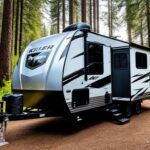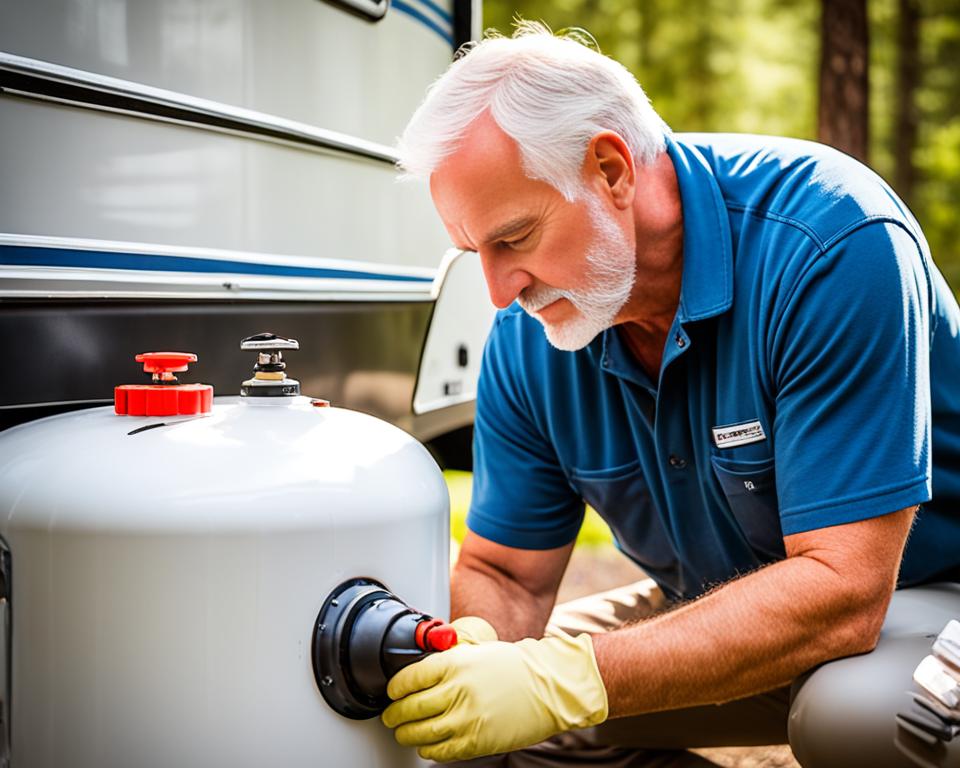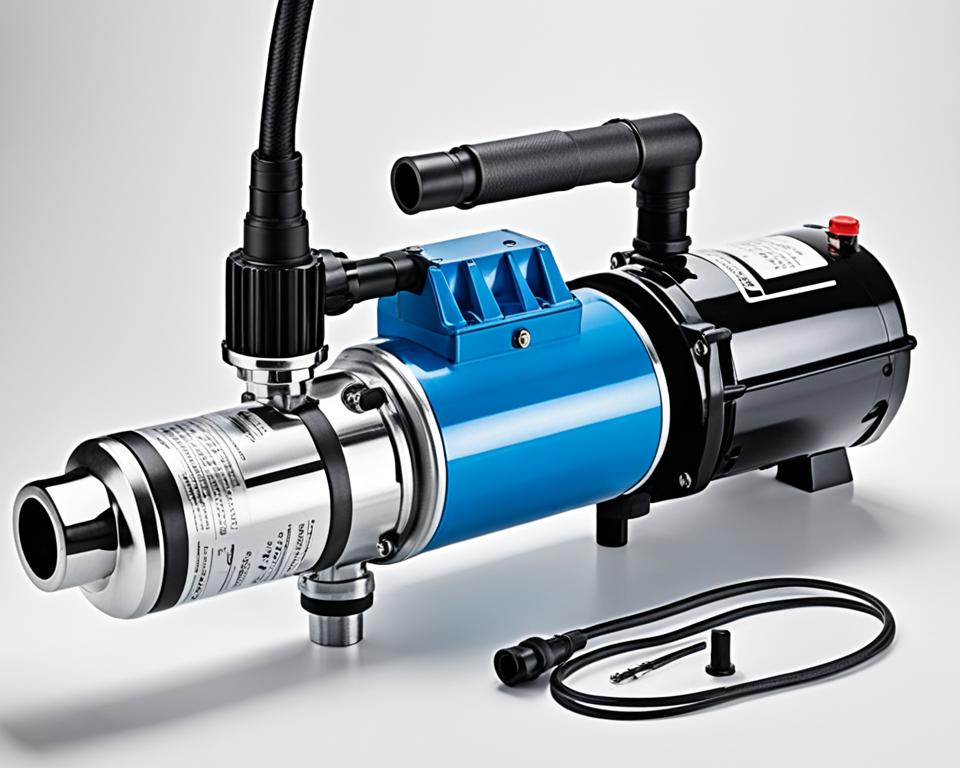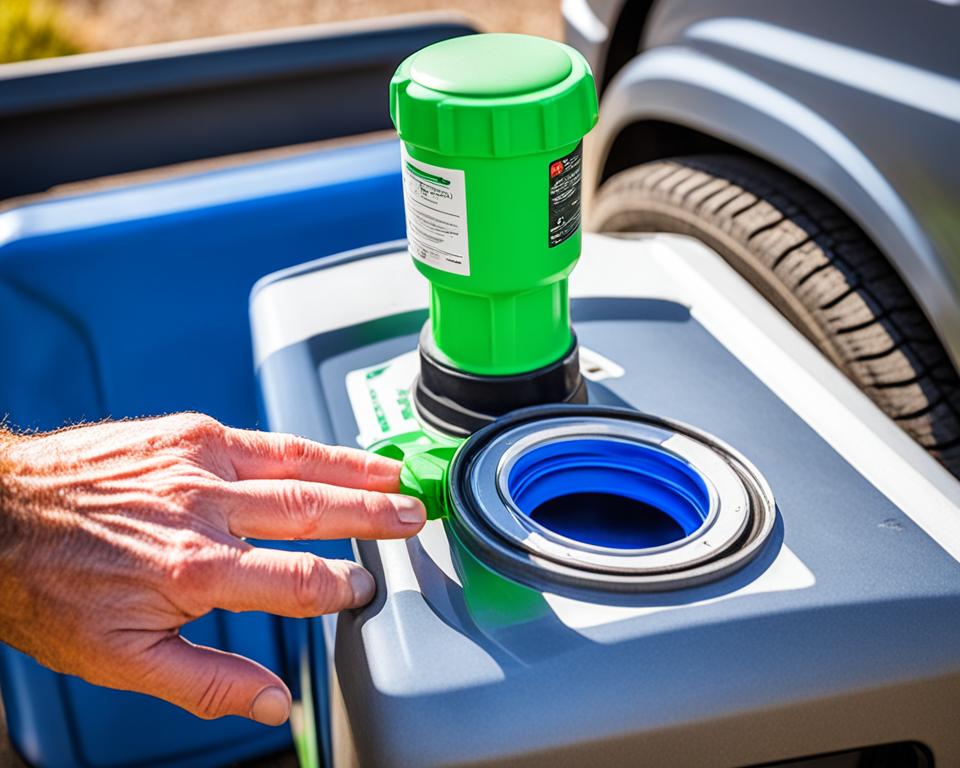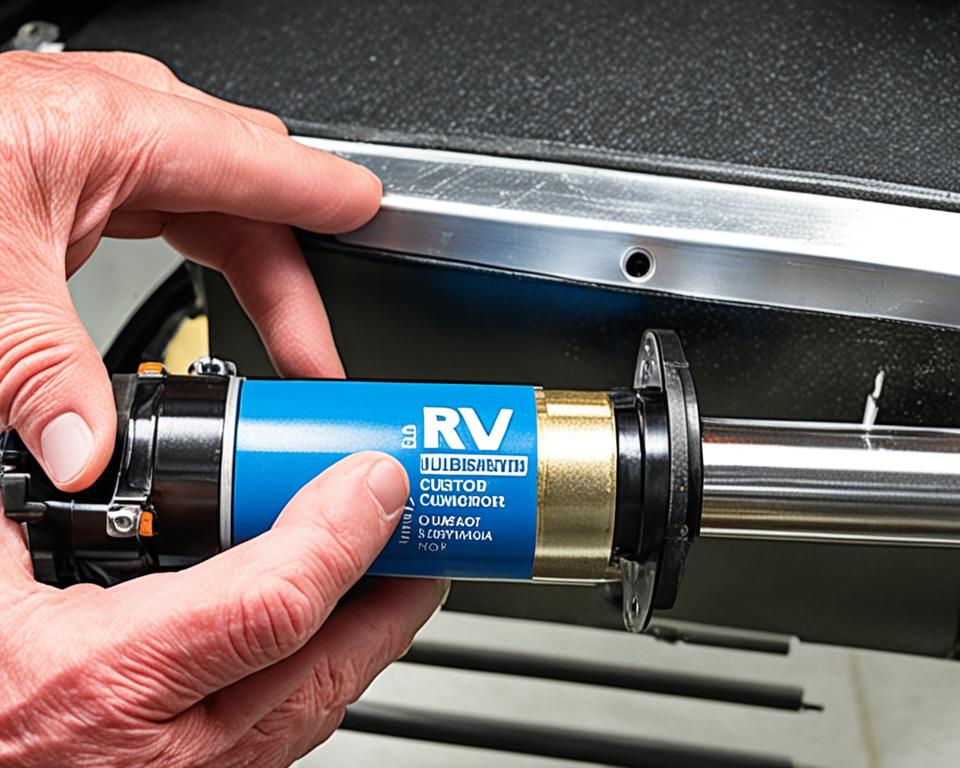Proper care and maintenance are vital for extending the life of your RV awning. Whether you’re an avid traveler or a weekend camper, taking the time to maintain your awning will ensure its longevity and maximize its durability.
The RV awning is not only a functional accessory that provides shelter from the sun and rain, but it also adds charm and aesthetic appeal to your outdoor space. By following a few simple maintenance tips, you can keep your awning in excellent condition and enjoy its benefits for years to come.
Key Takeaways:
- Regular RV awning maintenance is crucial for prolonging its lifespan.
- Understanding the different types of awning fabric helps in proper cleaning and maintenance.
- Inspecting for tears, mold, and dirt is essential for early identification of issues.
- Cleaning your awning regularly with gentle methods helps in its maintenance.
- Properly securing your awning and storing it when not in use prevents damage.
Understanding RV Awning Fabric Types
When it comes to RV awnings, understanding the different fabric types is crucial for proper cleaning and maintenance. There are two main types of RV awning fabric: vinyl and acrylic.
1. Vinyl Fabric
Vinyl fabric is known for its durability and resistance to mildew. This type of fabric is ideal for RV owners who prioritize longevity and reliability. With proper care, vinyl fabric can withstand the harsh outdoor elements and remain in excellent condition for years to come.
2. Acrylic Fabric
On the other hand, acrylic fabric offers a lightweight and breathable alternative. It allows for better airflow, making it an excellent choice for camping in warmer climates. Acrylic fabric is also known for its vibrant colors and resistance to fading, ensuring your awning stays aesthetically pleasing over time.
Both vinyl and acrylic fabric have their own unique benefits, and the choice ultimately depends on your personal preferences and the specific needs of your RV. Consider factors such as climate, usage frequency, and desired aesthetics when selecting the right fabric for your awning.
It’s important to note that regardless of the fabric type, regular cleaning and maintenance are essential for prolonging the lifespan of your RV awning. Proper care will not only preserve its appearance but also prevent mold, mildew, and other issues that can compromise the fabric’s integrity.
Regular Inspections for Awning Tears and Damage
Regularly inspecting your RV awning is essential to ensure its longevity and prevent potential issues. By performing detailed inspections before and after each trip, you can identify any tears, rips, or damage, as well as any buildup of mold or dirt. Addressing these issues promptly will help prevent further damage and costly repairs in the future.
When inspecting your RV awning, pay close attention to the fabric for any visible signs of tears or rips. Look for any areas that may have been snagged or damaged during travel or while setting up and taking down the awning. Additionally, check the seams and stitching to ensure they are intact and not coming undone.
Mold and dirt can accumulate on the fabric’s surface, especially during extended periods of use or when parked under trees or in moist environments. Inspecting for any signs of mold growth or excessive dirt buildup is crucial. These issues can not only affect the overall aesthetics of your awning but also compromise its durability and functionality.
To perform a thorough inspection:
- Start by extending your awning fully to expose the entire fabric surface.
- Examine the fabric carefully, visually inspecting for any tears, rips, or punctures.
- Check the seams and stitching to ensure they are intact and secure.
- Inspect the fabric for any signs of mold or excessive dirt buildup.
- If necessary, use a soft brush to gently remove any loose dirt or debris.
By regularly inspecting your RV awning, you can catch any issues early on and take appropriate action to prevent further damage. Promptly addressing tears, mold, and dirt buildup will help maintain the integrity of your awning and ensure its longevity.
Example Inspection Checklist:
| Item | Action |
|---|---|
| Fabric tears or rips | Repair or seek professional assistance if necessary |
| Seam and stitching integrity | Ensure all seams and stitches are intact |
| Mold or dirt buildup | Clean the fabric regularly and address mold growth promptly |
Cleaning Your RV Awning
Regular cleaning is essential for maintaining your RV awning and ensuring its longevity. Neglecting proper cleaning can lead to the buildup of dirt, debris, and stains, which can eventually damage the fabric.
To clean your RV awning effectively, follow these steps:
Gentle Hose Off
Start by hosing off the fabric regularly to remove loose dirt and debris. This simple step helps prevent the accumulation of dirt and minimizes the need for intense scrubbing later on.
Soft-bristled Brush and Soapy Water
For a thorough cleaning, use a soft-bristled brush and a mixture of mild dish soap and water. Gently scrub the fabric in a circular motion, paying extra attention to stained or heavily soiled areas. Avoid harsh scrubbing that can damage the fabric.
Spot Treatment
For stubborn stains or spots, spot treat the affected areas with a gentle fabric cleaner or a mixture of vinegar and water. Always test the cleaning solution on a small, inconspicuous area of the fabric to ensure it doesn’t cause discoloration or damage.
Avoid Harsh Chemicals
Avoid using harsh chemicals, bleach, or abrasive cleaners on your RV awning fabric. These substances can weaken the fabric, fade the colors, and reduce the water repellency. Stick to mild soapy water and gentle cleaning products specifically designed for awnings.
Rinse Thoroughly
After cleaning, rinse the awning fabric thoroughly with clean water to remove any soap residue. Soap residue left on the fabric can attract dirt and cause discoloration over time.
Allow Proper Drying
Allow the awning fabric to air dry completely before retracting or storing it. Proper drying helps prevent the growth of mold and mildew, which can cause unpleasant odors and damage the fabric. Avoid rolling up a wet or damp awning, as it can lead to musty smells and potential fabric deterioration.
By following these cleaning steps, you can ensure that your RV awning stays clean, well-maintained, and ready for your next outdoor adventure.
Quick Tip:
If you’re unsure about cleaning methods or if your RV awning requires specialized care, consult the manufacturer’s guidelines or seek professional assistance to ensure you don’t accidentally damage the fabric.
Securing Your Awning
To ensure the safety and longevity of your RV awning, it’s important to secure it properly, especially during windy conditions. Two popular options for awning security are saver clamps and tie-down kits. These accessories provide extra stability and minimize the risk of damage caused by strong winds.
Before embarking on any journey, take a few moments to tighten the knobs on the side arms of your awning. This simple step will help keep the awning securely in place while on the road, preventing any unnecessary wear and tear.
To provide added security against violent winds, utilize a saver clamp or a tie-down kit. These devices are designed to keep your awning in place, even during inclement weather. They attach to the awning pole and anchor it to the ground, preventing the awning from being blown away.
When using a saver clamp, place it towards the outer end of the main awning tube and tighten it securely. This will help maintain a stable structure even in windy conditions. Saver clamps are adjustable and easy to install, offering peace of mind knowing that your awning is securely fastened.
A tie-down kit is another effective option for awning security. It consists of straps that securely fasten the outer edge of the awning to the ground. This kit helps distribute the tension caused by gusts of wind along the entire length of the awning, reducing the risk of damage.
When using a tie-down kit, make sure to follow the manufacturer’s instructions carefully. Securely fasten the straps to solid anchor points on the ground, ensuring a tight and stable connection between the awning and the earth below.
Remember, proper awning security not only protects your investment but also ensures a hassle-free camping experience. By using a saver clamp or tie-down kit, and regularly tightening the knobs on the side arms, you can enjoy peace of mind knowing that your awning is secure.
| Advantages of Saver Clamps | Advantages of Tie-Down Kits |
|---|---|
|
|
Storing Your Awning When Not in Use
Proper storage is essential for preserving the quality and lifespan of your RV awning. By storing it away when not in use, you can protect it from the elements and prevent unnecessary wear and tear. Here are some tips on how to store your awning:
- Clean and dry: Before storing your RV awning, make sure it is clean and completely dry. Any residual dirt or moisture can lead to mold, mildew, or fabric damage over time. Use a soft brush and mild detergent, if necessary, to remove any stubborn stains.
- Roll it up: Roll up your awning carefully, making sure it is aligned properly and without any folds or creases. This will prevent permanent damage to the fabric.
- Protective cover: Consider using a protective cover specifically designed for RV awnings. This will shield your awning from dust, dirt, and UV rays, providing an extra layer of protection.
- Store in a dry location: Find a dry and well-ventilated area to store your awning. Avoid damp or humid spaces, as they can promote mold or mildew growth. A storage compartment or garage is ideal.
By following these storage practices, you can ensure that your RV awning remains in great shape, ready for your next outdoor adventure.

Avoiding Unattended Awning Damage
When it comes to protecting your RV awning, prevention is key. Avoiding unattended awning damage can save you from unexpected repair costs and ensure the longevity of your outdoor shelter. One of the essential steps in preventing damage is monitoring the weather forecast and being proactive in retracting your awning when necessary.
Heavy rainfall and strong winds can pose a significant threat to your RV awning. Leaving it unattended during inclement weather increases the risk of tears, fabric stretching, and even complete detachment. To prevent such damage, it’s crucial to stay informed about the weather conditions during your camping trip or when your RV is parked outdoors.
By diligently monitoring the weather forecast, you can anticipate impending storms or high wind speeds and take preventive action. If severe weather is expected, make sure to retract your RV awning well before it hits. It’s always better to be safe than sorry.
Retracting the awning can be done manually or with the help of an automated system if your RV is equipped with one. If you have a manual awning, familiarize yourself with the proper retracting procedure to ensure smooth and hassle-free operation.
Remember, even if the weather appears calm at the moment, conditions can change quickly. It’s important to exercise caution and vigilance in protecting your RV awning at all times. A few minutes of retracting can save you from potential damage and extensive repair costs down the line.
“Don’t let your RV awning bear the brunt of Mother Nature’s fury. Stay diligent, monitor the weather, and retract your awning when necessary.”
To recap the key points for avoiding unattended awning damage:
- Monitor the weather forecast regularly.
- Retract your awning before heavy rainfall or strong winds.
- Follow the proper retracting procedure for your awning type.
- Stay vigilant and don’t take chances with unpredictable weather conditions.
By being proactive and attentive to weather conditions, you can prevent unnecessary damage and ensure your RV awning remains in optimal condition for years to come.
| Weather Condition | Action |
|---|---|
| Heavy Rainfall | Retract the awning to prevent water pooling and potential fabric damage. |
| Strong Winds | Retract the awning to avoid tears, stretching, or complete detachment. |
| Severe Storm Warning | Retract the awning well in advance to protect it from high winds and potential flying debris. |
Keep in mind that while retracting your awning is crucial in avoiding damage, it’s equally important to inspect it for any tears, rips, or signs of wear and tear during regular maintenance routines. Addressing any issues promptly will prevent further damage and ensure the longevity of your RV awning.
Addressing Persistent Stains
If plain water is not enough to remove tough stains from your RV awning, there are a few effective methods you can try. One option is to use a soft brush and a mild detergent. Gently scrub the stained area using the brush and detergent, taking care not to damage the fabric. Rinse thoroughly with water to remove any soap residue.
Another option is to use specialized cleaning products specifically formulated for RV awnings. These products are designed to effectively remove stubborn stains without causing damage to the fabric. Follow the instructions provided on the product packaging for best results.
When using any cleaning method, it is important to avoid aggressive scrubbing. Applying too much pressure can not only damage the awning fabric but also compromise its waterproof coating, which is essential for protecting against rain and moisture.
Proper stain removal techniques can help restore the appearance of your RV awning and ensure its longevity.
In addition to regular cleaning, it is recommended to address stains promptly to prevent them from setting in and becoming more difficult to remove. By taking immediate action and using the appropriate cleaning methods, you can keep your RV awning looking clean, fresh, and stain-free for years to come.
Allowing Proper Drying Time
Ensuring that your RV awning is completely dry before storing it away is essential for preventing moisture-related issues. Moisture can lead to the growth of mold, mildew, and rot, which can compromise the fabric and structure of the awning.
Properly drying your RV awning after each use helps prevent these issues and prolongs its lifespan. Here are some tips to ensure effective drying:
- Roll up the awning gently, ensuring that there are no folds or creases that can trap moisture.
- If your awning has gathered moisture during use, extend it fully and allow it to air dry in a shaded area. Avoid direct sunlight as it may cause fading or damage to the fabric.
- Use a soft cloth or towel to pat dry any remaining moisture on the awning surface.
By taking the time to allow your RV awning to dry properly, you can prevent the buildup of moisture, mold, and mildew. This simple step will help maintain the integrity and longevity of your awning for years to come.
Lubricating Moving Parts
To ensure smooth operation and prevent unnecessary wear and tear on your RV awning, it’s crucial to lubricate the moving parts regularly. This includes rollers, hinges, and support arm pistons. Lubricating these components will keep them functioning optimally, allowing for easy extension and retraction of your awning.
The recommended lubricant for RV awning maintenance is silicone spray lubricant. Silicone lubricants are specifically formulated to withstand outdoor conditions and provide long-lasting protection against friction and corrosion. They also offer excellent water resistance, which is crucial for an awning exposed to rain and moisture.
When applying the silicone spray lubricant, make sure to follow these steps:
- Start by extending your RV awning fully.
- Apply a thin, even layer of silicone spray to the rollers, hinges, and support arm pistons.
- Use a clean cloth to wipe away any excess lubricant.
By lubricating your RV awning’s moving parts regularly, you’ll ensure smooth and effortless operation, reducing the chances of damage or malfunction. It’s important to note that using the right lubricant and technique is crucial to prevent slipping or gathering excess dirt on the awning fabric.
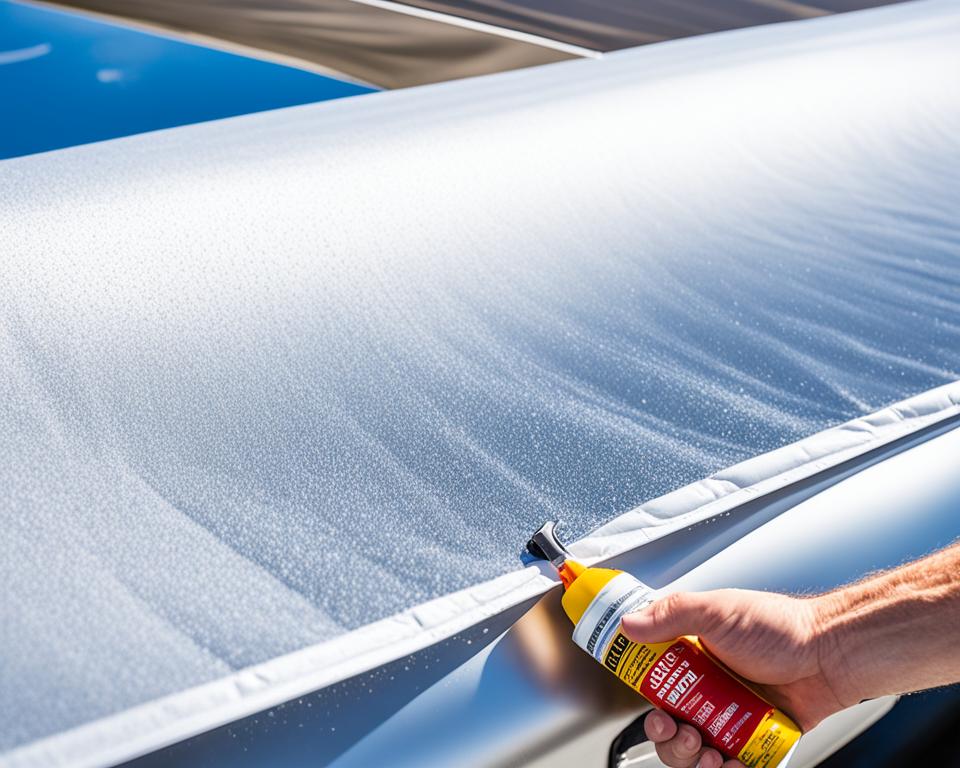
In addition to lubricating the moving parts, it’s essential to inspect them for any signs of damage or wear. If you notice any issues, such as bent or broken components, it’s best to address them promptly to avoid further complications.
Protecting from UV Damage
Prolonged exposure to UV rays can cause damage to the fabric of your RV awning. It’s important to take steps to protect it and ensure its longevity. Here are some tips to help you keep your awning safe from UV damage:
1. Keep it Rolled Up and Protected
When your RV awning is not in use, make sure to roll it up and secure it properly. Keeping it rolled up and protected from direct sunlight will minimize the exposure to UV rays. This simple action can go a long way in preserving the quality and lifespan of your awning.
2. Use Your Awning in Short Durations
While it’s great to enjoy the shade and comfort provided by your awning, try to use it in short durations whenever possible. By limiting its exposure to the sun, you can help minimize the risk of UV damage. This is especially important during the peak hours of sunlight when the UV rays are strongest.
| Sun Exposure Hours | Recommended Awning Usage |
|---|---|
| 9 AM – 11 AM | Minimal or no usage |
| 11 AM – 3 PM | Limited usage with caution |
| 3 PM – 5 PM | Safe for regular usage |
3. Ensure Proper Awning Storage
When you’re not using your RV awning for an extended period, proper storage is essential. Find a cool and dry place to store it, away from direct sunlight. Consider investing in an awning storage bag or cover for added protection.
“Protecting your RV awning from UV damage is crucial for its durability and longevity. By implementing these simple yet effective measures, you can enjoy your awning for years to come.”
By prioritizing the protection of your RV awning from UV damage, you can ensure that it remains in excellent condition. Remember to keep it rolled up when not in use, use it in short durations, and store it properly. These preventive measures will help preserve the fabric and extend the lifespan of your awning.
Conclusion
Proper maintenance and care are crucial for ensuring the long-lasting durability of your RV awning. By following a routine cleaning and inspection schedule, as well as taking proactive steps to protect your awning from the elements, you can extend its lifespan and keep it in excellent condition for years to come.
Regularly clean your RV awning by hosing off any dirt and debris and using a soft-bristled brush with a mixture of water and dish soap for a thorough cleaning. Avoid harsh scrubbing and harsh chemicals that can damage the fabric. Additionally, conduct regular inspections to identify any tears, mold, or dirt buildup that may require prompt attention.
Investing in high-quality replacement fabric if needed can improve both the appearance and functionality of your awning. Properly storing your awning when not in use and retracting it during inclement weather can also help protect it from potential damage. Remember to allow your awning to dry completely before storing it to prevent moisture-related issues such as mold and mildew.
By following these RV awning care tips and adopting a proactive approach, you can enjoy a long-lasting awning that enhances your RV experience and provides shade and protection for many memorable adventures.
FAQ
How often should I inspect my RV awning?
It is recommended to perform a detailed inspection before and after each trip to check for tears, rips, and any buildup of mold or dirt.
What is the best way to clean my RV awning?
Regularly hose off the fabric to prevent dirt buildup and use a soft-bristled brush with a mixture of water and dish soap for thorough cleaning. Avoid harsh scrubbing and chemical cleaners that can damage the fabric.
How can I secure my RV awning in strong winds?
To protect your awning from violent winds, use a saver clamp or tie-down kit to secure it. Additionally, ensure that the knobs on the side arms are tightened before every drive to prevent unnecessary wear and tear.
What should I do with my RV awning when I’m not using it?
When you’re not using your RV awning, pack it away to protect it from the elements and prevent unnecessary wear and tear. Proper storage will help extend its lifespan and keep it in great shape.
Should I retract my RV awning during bad weather?
It is advisable to monitor the weather forecast and retract your awning if necessary, especially during heavy rainfall or strong winds, to prevent damage from unpredictable weather conditions.
How do I remove tough stains from my RV awning?
If plain water is not enough, use a soft brush and mild detergent to clean stubborn stains. Specialized awning cleaning products can also be used. Avoid aggressive scrubbing to preserve the fabric’s waterproof coating.
Why is it important to ensure my RV awning is completely dry before storing it?
Moisture can lead to mold, mildew, and rot, compromising the fabric and structure of the awning. Proper drying is crucial for preventing these issues.
How can I lubricate the moving parts of my RV awning?
Regularly lubricate the moving parts of your RV awning, including rollers, hinges, and support arm pistons, using silicone spray lubricants. Wipe away excess lubricant to prevent slipping.
How can I protect my RV awning from UV damage?
Prolonged exposure to UV rays can damage the fabric of your RV awning. Keep it rolled up and protected when not in use to minimize UV damage. Using your awning in short durations can also help preserve its longevity.
What can I do to ensure my RV awning lasts as long as possible?
Proper maintenance and care are essential for maximizing the longevity of your RV awning. Regular cleaning, inspections, and protection from the elements will help ensure that your awning remains in excellent condition for years to come. Invest in high-quality replacement fabric if needed to improve its appearance and functionality.








